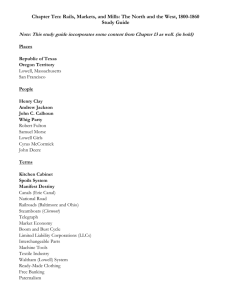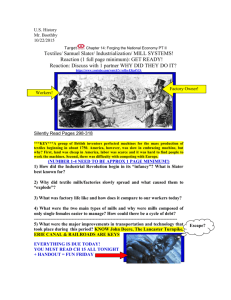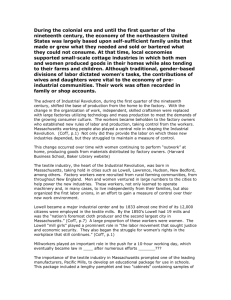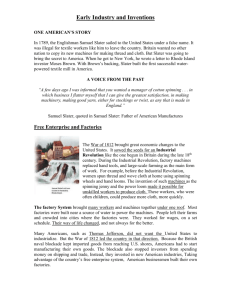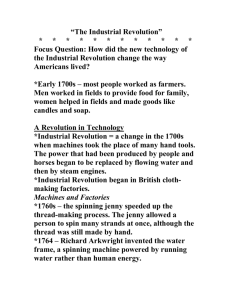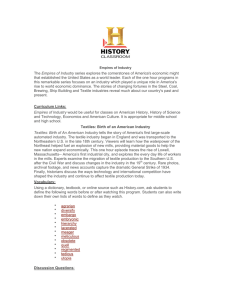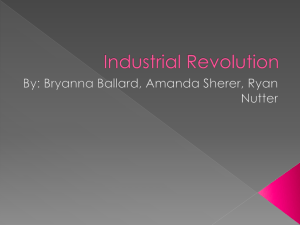Industrialization
advertisement
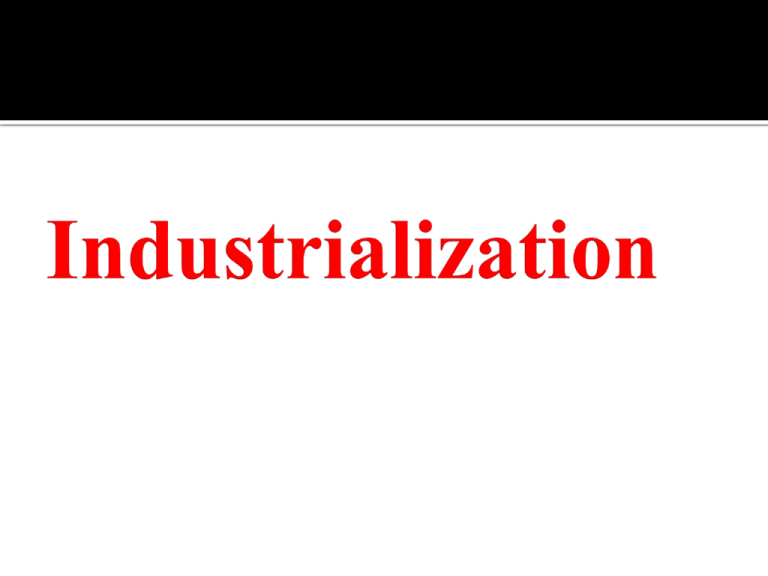
CICERO © 2008 The Industrial Revolution began in England in the 1780s with the invention of new tools and manufacturing techniques. The English went to great lengths to keep this new knowledge a secret and passed laws restricting the travel of engineers who knew the secrets of industrialization. The English knew if other countries learned this knowledge, they would face competition from Europe and the United States. An early English loom CICERO © 2008 The Slater Mill in Pawtucket, Rhode Island Samuel Slater and Moses Brown Samuel Slater was born in Derbyshire, England, in 1768. As a young man, he was apprenticed to Jedediah Strutt who operated a textile mill in Belper. Slater learned the manufacturing secrets of the English textile mills. To protect English manufacturing, British law prohibited anyone possessing manufacturing secrets from leaving England. American businessmen were offering cash rewards to anyone who could sneak this knowledge out of England and bring it to America. Hearing this, 22-year-old Slater disguised himself as a farmer and made his way to America. When he arrived in the United States, Slater contacted a Quaker merchant, Moses Brown, who wanted to build a textile mill. CICERO © 2008 Most of the fast-moving streams in New England were where the first American water-powered mills were constructed. Because there was an excess of farm laborers, these factories were ideal for unemployed people looking for work. At the beginning of the Industrial Revolution, the only real source of power came from using water. Early factories needed to be located on swiftly moving streams or rivers to turn the large water wheels which powered the factories through a series of belts and pulleys. CICERO © 2008 The Lowell Mills were the home of Francis Cabot Lowell’s Boston Manufacturing Company. The mills were located along the Merrimack River in Massachusetts. These mills combined many different processes of the manufacturing of textile products in one central location. By utilizing a multitude of spinning and weaving methods in one facility, the entire cloth-making process could be done in one place. The Lowell Mills helped to create the American Industrial Revolution. The mills employed large numbers of women. CICERO © 2008 Later, the Lowell Girls were female textile workers employed by Lowell Mills. They worked at the factory and even published the Lowell Offering, a monthly publication that featured articles about the women who worked in the mills. They also formed the Lowell Female Labor Reform Association in an attempt to gain a ten-hour workday. This was done after two separate strikes in 1834 and 1836 when Lowell Mills executives attempted to cut employee pay by fifteen percent. CICERO © 2008 Interchangeable parts were universal machine parts. Each part was compatible, which made production and repair of the product easier. Eli Whitney believed developing interchangeable parts could aid the production of muskets for the United States military. Whitney’s demonstration of assembling a gun made of interchangeable parts impressed government officials, and the United States ordered mass production of interchangeable parts for other military weapons. This concept later would be applied to the development of other machine tools. CICERO © 2008 Eli Whitney Standardization was the process of establishing a uniform method of production. Standardization would provide business with the best way to accomplish a task and then they could apply this method to other areas. Eli Whitney also was credited with originating the idea of standardization. Whitney used his concept of interchangeable parts to benefit the rifle market in 1797. Standardization revolutionized many labor markets. It provided for a growth of labor. Standardization also created set values the product must have before it was marketed. This meant each product had to meet an established standard of production. CICERO © 2008 Division of labor was the predecessor to the assembly line. Workers were given specific tasks to accomplish during a workday to increase a factory’s production. Division of Labor led to advances in production and trade. Some, including Karl Marx, spoke out against the division of labor. Marx stated this manufacturing process would become repetitive and cause workers to be alienated from one another and from the work they were doing. CICERO © 2008 The assembly line was necessary for the production of interchangeable parts. By utilizing many workers in a line, each had a particular task when assembling a product. This way products would not only be produced effectively but also produced in a timely manner. There have been many examples of assembly lines over the years, including ones for firearms and watches. The most wellknown version of the assembly line was used in the production of automobiles by the Ford Motor Company. The assembly line ensured consumers who purchased a Model T Ford were guaranteed a standardized, reliable, and predictable product at a reasonable price. CICERO © 2008 Mass Production Mass production is the production of large amounts of standardized products, including and especially on assembly lines. It allows businesses to produce a large amount of goods while making efficient use of all resources, including time. Each good produced is identical and not unique in anyway. Child Labor The use of children as factory workers was a common practice during the early industrial revolution. During the time there was little or no public education so it was seen as a way to make children productive members of society and contribute to the family. Children often worked the most dangerous jobs, worked in bad conditions, and were beaten when they made mistakes at work. Transportation In order to ship the massive amounts of goods being produced in the factories massive investment in transportation improvements began. Steam engines powered boats and later trains. Eventually the automobile was developed. The improvements allowed for greater trade and movement for the people. Transportation however lead to greater levels of pollution and traffic. Urbanization The creation of factories meant that people had to live close to them in order to get to work. Urbanization occurred as Americans left the rural farms they once worked and moved to centralized locations. Towns grew to become cities which contained housing, stores, and entertainment. Early cities were often poorly planned and were crowded and often unsanitary.
